Since many Americans and Europeans are not familiar with how to use rice, we thought it would be nice to offer some ideas, mainly drawn from Asian cooking.
(The zero-carb dangers series is continuing, but as it’s science heavy I thought mixing in a food post would be fun.)
We make a soup every weekend and have a bowl to start dinner most days of the week. Chicken soup is a classic winter dish. We have a brief recipe in the book, but here is a variant. In the book recipe, the chicken is pulled out before it disintegrates, the meat and skin pulled from the bones and returned to the soup. Here, the chicken is left in the soup and cooked much longer to create a thicker and more nutritious broth. The downside is that many small chicken bones are left in the soup.
The Recipe
We like a garlic-salt-and-pepper flavor. Garlic is very important for the flavor of the soup; use at least 12 cloves, I prefer 20. Slice each clove in half so that the flavor seeps into the broth more easily.
Use enough water for the chicken to float but not swim:
For the most nourishing broth, simmer 2-3 hours. Skim off scum that rises to the top, but don’t skim off fat. If you wish a soup with less protein, remove the chicken breast meat after one hour, returning the rest of the chicken to the soup; the breast meat can be used for other dishes, like chicken salad.
Meanwhile, you can pre-soak some uncooked rice in water. This helps the rice open in the soup:
After 30 minutes or more of soaking, pour off this water to remove starch and surface contaminants, then add the rice to the soup. Cook another 1 hour. With shorter cooking, the rice remains intact; with longer cooking the rice releases starch into the broth for a thicker broth.
By this time the chicken should be falling apart. Use a spoon to break it to small pieces. Add salt and pepper and other spices to taste. In the last half hour, you can add any vegetables you wish to cook in the soup.
You can also add vegetables after the soup is finished, for a crunchier texture. In this case we added cilantro, carrots, and scallions:
Finally, after cooking is done and just before eating, you can add fat sources to hot soup for a richer taste. We use egg yolks or heavy cream. I rather like cream with turmeric. Here is how it looks with three egg yolks:







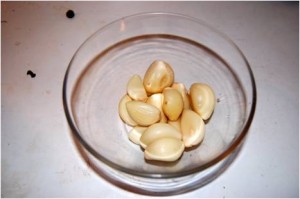
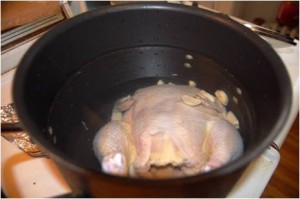
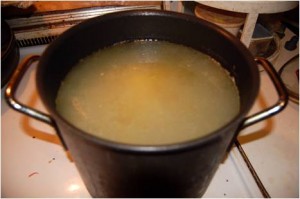
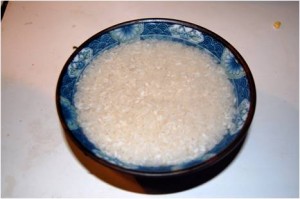
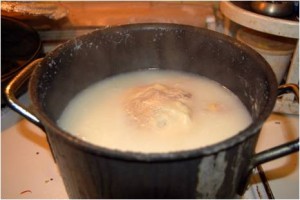
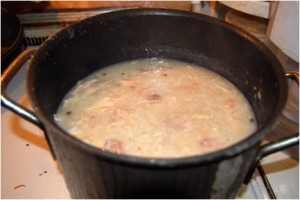
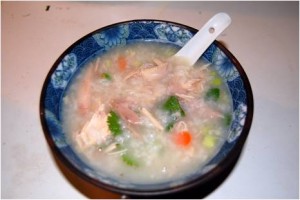
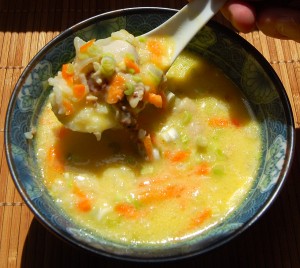




That soup looks fantastic. That may have to be consumed the coming weekend!
Thank you for the recipe!
In health,
Brandon
Looks and sounds great. Leaving to work out and buy a few groceries shortly. Fortuitously confluent, fresh chicken is on sale. (r those real words?)
Thanks for the series explaining more about why super low carb might not be a good idea. I’m enjoying eating potatoes and white rice again.
What about the chicken bones? Do they completely disintegrate? Otherwise it looks yummy.
Hi erp,
The bones are still there, but the joints disintegrate so they are in small pieces. If you cook it long enough so the bones are clean, I don’t mind having the bones in the soup.
For a boneless soup, cook briefly enough that the chicken hangs together, then you can pull the whole chicken out, tear the meat off the bones and return that to the soup.
Great post! The farmer we buy our eggs and goat’s milk from has been trying to get rid of a bunch of old hens that aren’t laying anymore. The price is great, but he said the meat might not be good for much but soup. Now I know what we’ll do with them!
Haha, it’s so weird because this is the diet I follow: paleo-ish with starch and some rice if I crave it. This looks a little like congee, which is one of my favorite dishes.
There is a popular saying in Brazil:
“Prudence, money in your pocket and chicken broth don’t hurt nobody”!
Mario – We may be lacking in the first two, but at least we have the third!
Paul,
Sounds delicious, but isn’t that quite a lot of omega six fat from a whole chicken (ie without draining some)? Seems like that would make it hard to observe your O6 limits.
Yes, but the soup is our only chicken of the week, and we alternate soups — beef soups about half the time, seaweed soups and fish soups frequently. Overall I don’t think our omega-6 intake is that high. Most of our meat during the week is beef or seafood, usually salmon, so our biggest omega-6 source is probably egg yolks.
I think in the book we recommend low omega-6 foods like beef and salmon four days a week and moderate omega-6 foods like chicken and pork and olive oil no more than 3 days a week. One could have the same concern about bacon; it’s good in moderation, but too much would raise omega-6 levels.
Nice post. I was hoping you would toss out a few more ideas for using egg yolks as you mention in your book. I am going to cut back egg consumption a bit due to the omega-6 issue, and also start tossing a few whites and use the yolks instead of making my all too frequent omelets. Keep the great ideas coming!
Hi Rodney – Well, I’m sure the “Cooking with Rice” series will have a fried rice recipe, which uses egg yolks (or eggs). Bibimbap is similar.
We also welcome guest posts. If anyone wants to share their favorite recipes, we’ll put that up.
Hi Paul!
Just yesterday found your great blog here, ordered the book and wanted imediately to jump on! You just make an aweful lot of sense!
As I don’t have the book yet (and won’t have it the next 10 days- I’m in europe) the emphasis of avoiding omega-6 slipped a bit and my dinner did include too much olive oil and fatty pork (I just like pork) and a bit of bacon, I’m afraid. I used plenty of butter too with both my brussels sprouts and rice with carrots, so maybe it was ok. Later I had a shake from frozen strawberries and heavy cream and a bit milk. It was delicious for sure!
Now the question, besides butter and ghee, which fats/oils are safe? I can’t get coconut oil here (at least not quickly) but what’s about hazelnut/macadamia/walnut/almond?
Albeit very expensive I can get it.
Thanks!
Paul,
Have you seen this:
http://www.sciencedaily.com/releases/2010/11/101117184457.htm
By the way, do you have sour tapioca (cassava) flour in US? If you have, I can share a brazilian cheese bread recipe (sour tapioca flour, parmesan cheese, water, milk, eggs, butter and salt)!
http://luciaadverse.files.wordpress.com/2009/05/pao-de-queijo-1.jpg
Hi Franco,
No problem with olive oil and pork from time to time!
You can check macronutrient content at http://nutritiondata.com. Generally for nuts, omega-6 less than 10%, eat as much as you want; omega-6 10%-30%, eat in limited amounts; omega-6 greater than 30%, avoid. Macadamia are like 3%, so no limits; hazelnut, 13%, eat in moderation like pork; almond, 24%, eat in limited amounts; walnut, 72%, don’t eat.
You might be able to find palm kernel oil in place of coconut oil as a ketogenic fat.
Animal fats like beef tallow/fat are more nutritious than plant oils, see my choline post recently.
Hi Paul! Your reply to Franco on 11/19/10 was very helpful to me too! Thank you kindly for the input. 😆
Hi Mario,
No, I missed that one, thanks! Another paper for the “Vitamin C helps against infections” file.
I haven’t seen sour tapioca flour in the US. Here’s what Amazon sells:
http://www.amazon.com/s/ref=nb_sb_noss?url=search-alias%3Daps&field-keywords=sour+tapioca+flour
None of them say “sour”, is that different?
Anyway, we’d love to get your recipe regardless. Send pictures for your guest post! We don’t bake ourselves, but I’m sure lots of Americans who do would love to learn how to bake with safe starches. And maybe we would learn, your cheesebread looks scrumptious!
We don’t bake anymore either, only cheese bread! We LOVE cheese bread!!
Well, brazilian cheese bread can be made from “regular” or sour tapioca flour (but with sour flour the bread smells and tastes better!). To make sour tapioca flour they put the cassava starch to ferment for 30 days.
Next time I made it, I’ll take pictures for you, but in the meantime, if anyone is interested, there is a recipe here (instead of margarine, use butter or lard):
http://www.food.com/recipe/pao-de-queijo-cheese-puffs-brazilian-68293
We sometimes eat tapioca/manioc/cassava prepared products like these: Frozen Pao de Queijo bread called “Cheenies.” The only thing we don’t like about this item is that soybean oil is one of the ingredients. http://www.cheenies.com/PRODUCT.HTML
There is also a bread mix called: http://www.chebe.com/
Here’s another company that makes pizzas and bread products with tapioca flour, but unfortunately these products contain canola oil: http://www.againstthegraingourmet.com/ingredients-matter.html
I might try making Brazilian cheese rolls from scratch using that sour tapioca flour, thanks!
Thanks, Suzan. It’s nice to see our food choices are broadening!
We make a similar chicken soup. We add fresh ginger, and instead of cream, we use coconut milk and then a squeeze of lime at serving time. It’s very addicting! I’ll have to try your rice method, thanks.
Hi Paul, Do you have any thoughts about gelatin intake which Ray Peat promotes?
Would it be useful if one consumes a lot of muscle meat?
Cheers
Hi Marc,
We think it’s desirable. That’s one reason we favor a lot of bone and joint soups, beef tendon stews, ox tail, etc. The whole-chicken soup has gelatin in the soup.
If you have high protein intake from meat you probably don’t need the gelatin, although there could be useful hormonal effects from getting a better mix of amino acids. But on lower protein intakes, eating like your whole body, not just muscle tissue, is more important.
Thanks again, Paul,
I’m just in the process to make my ghee and will stick with that for now.
When I change countries (east to west europe) in 10 days it will be much easier to get the coconut oil.
I always feel pretty good after eating chicken.
Whether it’s plain chicken breasts (covered in melted butter, of course) or dark meat, skin, bones, etc.
Just a nice sense of feeling better. Don’t know if it’s amino acids, protein, nostalgia from years of eating dry chicken on the SAD, or maybe some of us need more O6?
You could try a dose of soybean oil, see if that makes you feel good.
I don’t recommend it though …
I like to do our chicken in a slow cooker. We pull the meat out when it’s ready, but continue to cook the carcass for overnight, for 16- 20 hours. The broth is amazing.
It would add an extra day to your soup directions, Paul, but wow, so good.
Yes same here, I would pull the meat out then crack the bones and continue to simmer with some leek. This eventually leaves a gelatin broth. Lovely stuff.
Thanks, Michelle, we’ll try that way next time. At least the home will smell great!
Looks delish! What do you do with the skin? I’m not too big a fan of chicken fat (for the O6 reasons mentioned above). I usually eat most of my chicken then throw the skin and bones (with adhering meat and cartilage) in water to make broth. I’ll strain out the bones to rescue the rest of the meat after a short time and then let it simmer good and long. After that I refrigerate the strained broth and skim off most of the fat. I usually use this as a base for my cream of wild mushroom soup.
Thanks to Mario for mentioning tapioca. Another way for me to add starch carbs to my food options!
could you extrapolate on your preference for white vs brown rice. your book covers this briefly, but I am curious if you had some further rationale on this viewpoint. thanks.
Hi Steve,
It’s very simple – in regard to plant foods we believe avoiding toxins is of paramount importance, grains tend to have bad toxins, if there are toxins in rice they’re in the protein which is largely removed in the milling of white rice.
Grains do not provide much micronutrition, so you’re just trying to get a macronutrient – glucose – from them, with as little toxicity as possible. White rice fits the bill better than brown rice.
Just finished reading new book…still trying to wrap my head around white rice being more beneficial than brown, given brown rice’s superiority has been pounded into my head for last several years. So, ok, what kind of white rice..one “better” than another? and thanks for the presoaking idea.
LK
Hi lk,
Asian varieties of rice are generally lower in arsenic than American rice, although there are exceptions. We’ve recently shifted toward lower glycemic index varieties like Basmati. However, all common rice varieties are OK as long as they’re eaten in a meal that conforms to the PHD food plate.
Best, Paul
I finally tried the egg yolks in the chicken soup– wow! Delicious! I’ll never go back to yolk-less chicken soup again! The other huge plus is that we are blessed to currently be getting eggs from a small family farm and the yolks are huge and orange and delicious! No comparison to any grocery store egg.
I made this soup today and boy is it good! I put a whole chicken with skin and bones in with 12 cloves of garlic and water. I forgot to take out the giblets. Next time I will add 20 cloves because I love garlic. Then I added the soaked white rice and let it cook longer. Deboned the chicken and added carrots, onion, celery, and S&P to taste. Then at the end I added both cream and an egg yolk (instead of 3 yolks vs cream because I really wanted both!) Maybe next time I will add 2 yolks and heavy cream, but the result was excellent. The chicken was very tender and flavorful and the broth was fairly thick and tasty! This recipe beats any chicken soup I’ve ever made before. Thanks!
Just tried this recipe and it tastes great! Just added too much rice.
How would you weigh thhe advantages vs disadvantages of presoaking white rice? I mean you lose the b vitamins and starchy content with soaking. And what’s the maximumsoakingtime you would generally recommend?